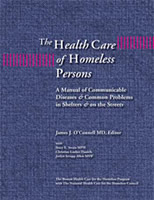Adapted Clinical Guidelines
Adapting Your Practice: Treatment and Recommendations for Homeless Patients with Chlamydial or Gonococcal Infections (2013) | Recommended clinical practice adaptations for the care of individuals with these sexually transmitted diseases who are homeless; developed by clinicians working in HCH projects.
Adapting Your Practice: Treatment and Recommendations for Homeless Patients with HIV/AIDS (2013) | Recommended clinical practice adaptations for the care of individuals with human immunodeficiency virus or acquired immunodeficiency syndrome who are homeless; developed by clinicians working in HCH projects.
Healing Hands Articles
- Homeless People at Higher Risk for CA-MRSA, HIV and TB (2006)
- Chronic Hepatitis C: Silent Intruder, Insidious Threat (1999)
- Tuberculosis & Homelessness: Metaphor for Our Time (1999)
- Network to Study HIV and Homelessness (1998)
Other Resources
Prevention & Response to Infectious Diseases Within the Homeless Population (2016) | Prevention and response procedures to infectious disease outbreaks often do not address the unique circumstances of persons experiencing homelessness. This fact sheet highlights infectious diseases within this population, addresses challenges in in the event of an outbreak, and provides strategies a nd tools that can be used to prevent and respond to emerging and re-emerging infectious diseases.
nd tools that can be used to prevent and respond to emerging and re-emerging infectious diseases.
Guide to Infection Prevention for Outpatient Settings: Minimum Expectations for Safe Care (2011) | This document from the Centers for Disease Control & Prevention describes the minimum precautions expected in ambulatory settings regarding the prevention of health care-associated infections.
The Health Care of Homeless Persons: A Manual of Communicable Diseases & Common Problems in Shelters & on the Streets (2004) | This lavishly illustrated, 384-page manual describes serious health problems that commonly afflict people experiencing homelessness and discusses appropriate responses and treatment. The manual addresses communicable disease control and food handling in shelter settings as well as current approaches to the management of chronic diseases. It includes convenient patient education materials in English and Spanish that can be easily reproduced and given to shelter guests and staff. The manual is no longer available in print, but you may download it from the Boston Health Care for the Homeless Program website.
Comorbid TB and HIV in a Chronically Homeless Male: Social Isolation Compounds Stress of Medical Confinement (2006) | Homelessness, long recognized as a risk factor for tuberculosis, can also complicate treatment, as this case report demonstrates. HIV coinfection increases the risk of progression from latent TB infection to active tuberculosis. Clinicians experienced in the care of homeless persons stress the importance of maintaining communication with these patients, even during medical confinement, and recommend close collaboration among public health, hospital, and primary care providers during treatment.